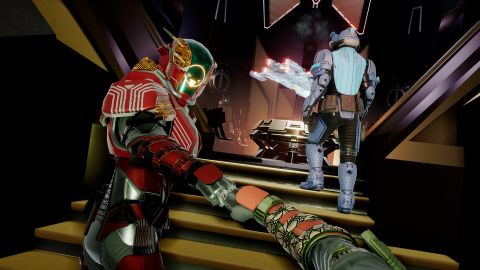Our Verdict
Void Crew lacks long-term depth, but it's already the best misfits-in-space game in the whole universe.
PC Gamer's got your back
What is it? A first-person spaceship 'em up for 1-4 players.
Expect to pay: $25 / £22
Developer: Hutlihut Games
Publisher: Focus Entertainment
Reviewed on: Ryzen 7 5800X 8-Core Processor, RTX 4080, 32GB RAM
Steam Deck: Playable
Link: Steam
Void Crew is a chaotic first-person mix of FTL: Faster Than Light and Sea of Thieves that asks you to take your team of one to four players and tumble through the galaxy, trying to keep your ship intact as you bounce between increasingly difficult space battles.
The structure actually is FTL. At the end of each encounter you'll power up the ship's void drive and hop into space, before going to a glowy 3D map to choose which of three missions you want to take a swing at next. They are varied, and while you inevitably end up throwing down with clouds of enemy ships, it does feel like there's a difference between, say, ambushing a convoy and wiping out shipyards.
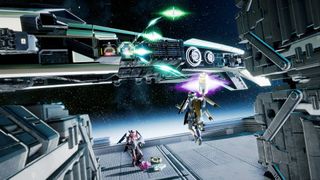
The end result is basically the best Firefly game ever made, with you and as many friends as you can cram into the ship waging a guerilla war in every direction, jumping away into the void just as things start to turn against you.
Your crew is divided into four different classes: Pilot, Engineer, Gunner and Scavenger. The roles are simple: the Pilot flies the ship, the Engineer fixes it, Gunners defend it, and the Scavenger… gets a grappling hook. The first three have skill trees that boost their specific niches and even give them a power-up that's perfectly suited for moments of do-or-die heroism, from letting Gunners supercharge their emplacements to the Engineer running faster and repairing quicker.
The Scavenger, meanwhile, has a loose hodgepodge of upgradable skills that makes them better outside of the ship. It's a role that’s just not needed - while hull breaches require someone to go out into wide open space to fix them, in that case you really want that someone to be an Engineer, who's better at the actual fixing. There are certain objectives that require you venture outside of the ship, too—but generally speaking, having someone off-ship is a negative. As a result, the Scavenger simultaneously offers both the most exciting possibility and most disappointing experience when you hop into a game for the first time. Compared to the other classes, there's not a clear fit for the Scavenger, so you feel anomalous in the ecosystem of keeping your little boat safe.
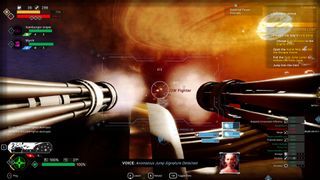
These roles are loose and you can multiclass, but because the farthest reaches of the skill trees for each role are so powerful, it seems inefficient to spec into other classes. When I level up a bit further it might turn out that I can pick up every different skill in every class—I haven't yet found the upper limit of how many skill points I can get—but because each successive skill feels like a huge leap forwards in terms of what is possible, it feels foolish to spread out your points early on.
There's a narrative here, but you can ignore it. The real story is the one you make. I couldn't tell you whether the faction you are aligned with, the METEM, are good guys or bad. But I can't stop thinking about our Engineer, who remained preternaturally calm as he bounced around the belly of the ship, powering up the void drive, extinguishing flames and fixing shorted wires to keep us alive long enough to make the jump outta dodge. This isn't the only tale of improbable survival Void Crew has given me, and honestly several of them hinge on my friend Tim being a calm engineering presence while the rest of us try our best not to get crushed by the unfeeling universe.

Still, Void Crew's story engine is far from the only hardware you'll be getting your hands on. This is a game all about spaceships and tinkering with them.
Void Crew's ships feel like they were made by Fisher-Price, all big buttons for opening the airlock door and chunky levers for depressurising afterwards. You can interact with just about everything using a quick tap of the F key, and most things are quite self-explanatory. Constructing new modules in your ship is a simple case of dragging a box into an empty space and then turning a handle on the top. You deconstruct parts of your ship by pulling a big lever in the base of each part. You can do this at any time, but outside of slapping a shield generator down mid-fight it's hard to imagine why you would want to do it anywhere outside of the relaxing safety of the void tunnel.
Void Crew's ships feel like they were made by Fisher-Price, all big buttons for opening the airlock door and chunky levers for depressurising afterwards
The Frigate is easy to pilot and maintain, but the Destroyer is huge and feels like a stretch for a four-person team to keep afloat. You unlock several different configurations with their own specialities, whether that's a CQB (Close Quarters Battle) ship that starts with two whirring miniguns, or an energy boat that offers more laser guns (and power issues) than you can shake a stick at.
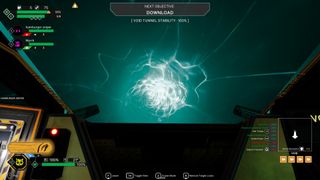
We didn't pick a favourite, but did find ourselves more comfortable on the smaller Frigate, and as we learned every inch of that ship, the game came alive—the team running around like little ants inside our colony. "I'm running out of ammo," I'd call out as I got to the last 600 rounds in my ridiculously fast-firing gatling gun. At this point, the Engineer would run from the engine room to the storage shelves, grab a box of ammo, leg it up to my emplacement at the back of the ship and load more ammo in. On the way back, he'd dip into the power room and take a battery from the charger, loading it into our shield and allowing us to take a tiny bit more punishment. From there, he'd take the empty battery from the shield to put it on charge, before returning to his nest in the engine room, keeping the engine trimmed and thrusters charged so our Pilot had as much mobility as possible.
It's a role he was born to play, and I think most groups will find people gravitating into their roles quite easily. My love of things that go boom make me a natural Gunner, but I also enjoyed the twists and turns of piloting, and found some peace in darting around the inside of the ship during combat as an Engineer.
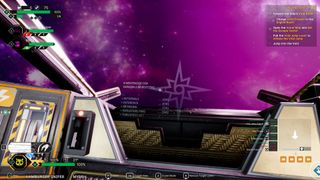
Ultimately though, it's the guns that draw me in. There's a range of different weaponry here, from long range snipers to gatling guns and everything in between. The energy weapons don't require ammo but draw a lot of power, while physical guns put out an unholy amount of damage and never overheat. Having to track enemies and then lead your shots is unusual in a game of this type, and a blast to get to grips with.
All in all, Void Crew feels like it has a good foundation here. There are a few omissions: as a Pilot it's weird that you can't control your pitch and yaw. And we've already covered how pointless the Scavenger feels. But the only major flaw is that there isn't quite enough content yet for sustained play. I've played a fun 20 hours but feel like I've just about seen everything, even if I haven't mastered much of it. My next challenge is to start topping the bosses: giant, screen-spanning things like a giant spike surrounded by turrets, or a hollow sun full of energy that will set your ship on fire from the inside as soon as its giant energy beam touches you. After that, I’m not sure what I’ll have left to do.
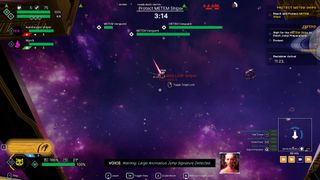
Still, Void Crew offers a compelling reason to go to a galaxy far, far, away—and while there are a few quirks here and there, this is a sci-fi blast of co-op chaos. Grab some friends, get out there and make your own stories.
Void Crew lacks long-term depth, but it's already the best misfits-in-space game in the whole universe.

In 2024 Elon Musk predicted that 'hundreds of millions' of people will have his brain chips within the next 20 years, so don't forget to hold him to it

PC Gamer Hardware Awards: The best gaming handheld of 2024

Webfishing has captured the old-school chatroom MMO vibes to perfection, and somehow made it so much better than I remember as a kid
